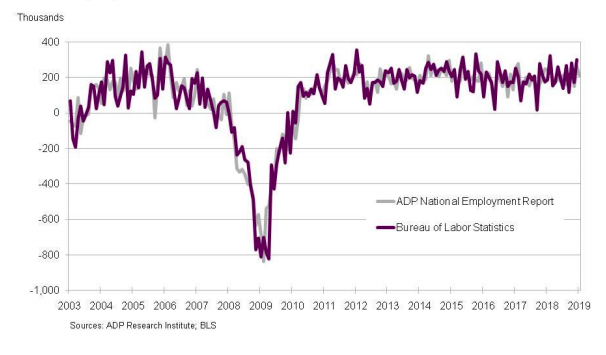Even political headwinds couldn't prevent U.S. employment rates from increasing in nearly every sector in January, according to the ADP and Moody's Analytics National Employment Report.
“The job market weathered the government shutdown well. Despite the severe disruptions, businesses continued to add aggressively to their payrolls,” Moody’s Analytics Chief Economist Mark Zandi said. “As long as businesses hire strongly the economic expansion will continue on.”
The National Employment Report indicates that private sector employment increased 213,000 jobs from December to January. Notably, the number of jobs added in December was revised down from 271,000 to 263,000.
The chart below demonstrates the rate of increase since 2013:
(Click to enlarge)
The report indicated that construction jobs climbed once again, and overall the goods-producing sector is predicted to increase by a tremendous 68,000 jobs.
Below is a breakdown of job segments that saw changes in employment between December and January:
Natural resources and mining: Decrease 1,000
Construction: Increase 35,000
Manufacturing: Increase 33,000
The service-providing sector is predicted to increase by 145,000 jobs, including:
Trade, transportation and utilities: Increase 13,000
Information: Increase 4,000
Financial activities: Increase 11,000
Professional and business services: Increase 46,000
Education and health services: Increase 38,000
Leisure and hospitality: Increase 31,000
Other services: Increase 2,000
ADP Vice President and Co-head Ahu Yildirmaz said the labor market has continued its pattern of strong growth with little sign of a slowdown in sight.
“We saw significant growth in nearly all industries, with manufacturing adding the most jobs in more than four years,” Yildirmaz continued. “Midsized businesses continue to lead job creation, however the share of jobs was spread a bit more evenly across all company sizes this month.”
NOTE: This report is a monthly measure of the change in total U.S. non-farm private employment derived from actual, anonymous payroll data of client companies served by the company. The data is collected and processed with statistical methodologies similar to those used by the U.S. Bureau of Labor Statistics.








